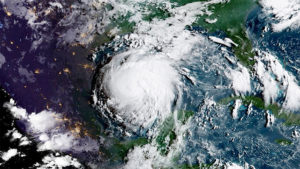In late August, Hurricane Harvey made landfall in Texas as a Category 4 storm. Harvey dropped record amounts of rain in southeast Texas and southwest Louisiana, triggering devastating flooding and causing an estimated $180 billion in damage, as reported by NPR. In the wake of the disaster, TIME also confirmed at least 70 Texans have died from Harvey-related causes.
 As areas hit by Harvey begin the slow process of rebuilding homes and infrastructure, one of the most powerful storms on record, Hurricane Irma, is barreling through the Caribbean and Florida. Analysts from the U.S. Global Change Research Program have partially attributed this unusually active hurricane season to climate change, and while climate scientists are often able to link extreme weather events to human activity, hurricanes are more complex.
As areas hit by Harvey begin the slow process of rebuilding homes and infrastructure, one of the most powerful storms on record, Hurricane Irma, is barreling through the Caribbean and Florida. Analysts from the U.S. Global Change Research Program have partially attributed this unusually active hurricane season to climate change, and while climate scientists are often able to link extreme weather events to human activity, hurricanes are more complex.
In an article for The New York Times, seasonal hurricane forecaster Gerry Bell said that his team had forecast that this hurricane season would be “above normal,” with 14-19 named storms and 2-5 major hurricanes. Naturally occurring climate pattern, such as the Atlantic multidecadal oscillation, also influence hurricane formation, Bell said. However, Bell did attribute some of the activity to warming temperatures, which allow the atmosphere to hold more moisture to fuel storms, as well as rising sea levels, which can increase the damage caused by storm surges.
To cope with increased need for federal aid after Harvey and Irma, Congress approved a disaster relief bill for $15.25 billion last week. This action assuaged concerns that the Federal Emergency Management Agency (FEMA) would be unable to handle the financial pressure of two major hurricanes as well as wildfires in the western U.S. According to NPR, this relief bill is likely “the first drop in the bucket,” as Harvey is expected to be one of the costliest hurricanes in history. The New York Times reported that the majority of homes in Harvey’s path were not insured against flooding, and FEMA officials estimate that 450,000 people will seek federal assistance.
The scale of the damage has prompted experts to wonder about federal ability to respond to natural disasters. In an NPR article, Gary Webb, professor of emergency management at University of North Texas, said that Irma’s following on the heels of Harvey “tests our capacity to respond at the federal level. Instead of talking about a disaster,” he said, “we may be talking about a catastrophe.”
Federal response to the situation is supplemented by the efforts of people like Houstonian Jim McIngvale, better known as “Mattress Mack.” The owner of several Gallery Furniture stores, McIngvale opened some of his stores to be used as shelters for those whose homes were uninhabitable. MgIngvale welcomed anyone in need to sleep on the new mattresses in his stores, and over 400 people responded. According to TIME, McIngvale spoke of the “incredible outpouring of support” of volunteers and citizens willing to donate items such as baby formula to the flood victims sheltered in his stores. In the aftermath of Harvey, the volunteer effort has encouraged those who lost homes and strengthened resolve, which will be needed: McIngvale said that “the flooding is over and the hard part has just begun.”
